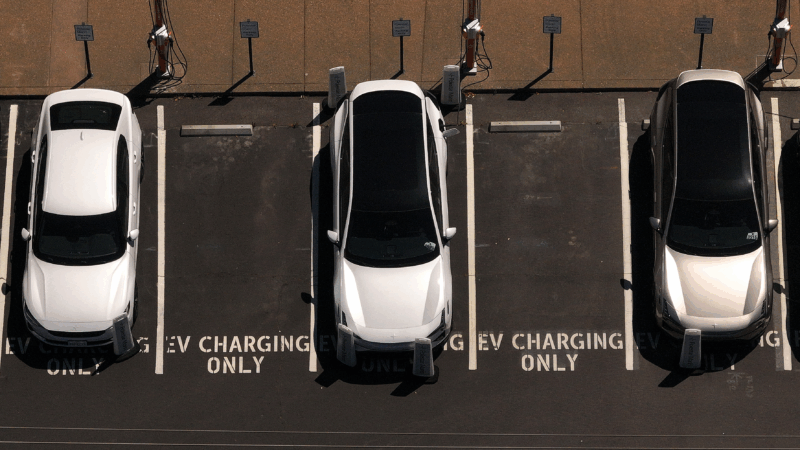ICE is making more arrests, but critics say some claims don’t add up
WASHINGTON, D.C. — The first month of the Trump administration’s crackdown yielded a jump in arrests by U.S. Immigration and Customs Enforcement.
But a closer look at the numbers suggests why the White House has been frustrated with the pace of arrests and deportations.
Immigration authorities are making more arrests per day on average than they did under President Biden. Yet the latest data from the Department of Homeland Security shows that ICE arrests still have not kept up with the goals set by Trump administration officials.
At first, the Trump administration published frequent updates announcing the daily ICE arrest totals, which peaked at more than 1,000 per day. But in February, those daily updates stopped.
The most recent DHS data released this week shows that fewer than 600 people per day have been booked into ICE detention facilities across the country during the first three weeks of February — well below the pace of 1,200 to 1,500 arrests a day that administration officials have said they want.
That hasn’t stopped the Trump administration from making some bold claims.
Homeland Security Secretary Kristi Noem announced this week that the administration had arrested 20,000 immigrants without legal status in its first month. That’s more than ICE had been arresting on average under the Biden administration, though still not enough to satisfy the White House’s stated quota.
Then Noem went a step further. In an official statement from DHS, she said that ICE’s February arrest total represents a “627% increase in monthly arrests compared to just 33,000 at large arrests under Biden for ALL of last year,” a claim she repeated on social media.
But immigration experts say Noem’s math is misleading because she’s comparing total ICE arrests under the current administration with a smaller subset of arrests under another.
“She’s comparing apples to coconuts” in order to exaggerate the difference in arrests numbers, said Jason Houser, a former chief of staff at ICE during the Biden administration.
ICE made a total of more than 113,000 arrests last year. The vast majority were “custodial” arrests, meaning the target was already in the custody of state or local officials. A far smaller number of the arrests that ICE makes are considered “at large.”
But Noem’s statement doesn’t make any of that clear. It also doesn’t specify how many of the 20,000 arrests ICE made in February were considered “at large” arrests and how many were not, leaving immigration experts frustrated.
DHS did not reply to a request seeking clarification.
Houser says the Trump administration is pushing ICE officers to execute a series of large-scale enforcement actions that play well in the media, rather than focusing its resources on the most dangerous threats.
“It’s optics now,” Houser said. “It’s not about public safety anymore. It’s just about this volume number. And we are less safe for that.”
But Noem insists the Trump administration’s crackdown is making the country safer.
“President Trump and this Administration are saving lives every day because of the actions we are taking to secure the border and deport illegal alien criminals,” she said in a statement this week.
Still, White House officials including border czar Tom Homan have expressed frustration with the pace of arrests and removals, and several top ICE officials have already been removed from their posts.
The number of immigrants in ICE detention centers climbed this month to more than 43,000, the highest total since before the COVID pandemic during the first Trump administration. This week, ICE announced plans to expand its network of detention centers, including what it called the first new facility to open during the second Trump administration.
President Trump pledged during the 2024 election campaign to build the largest mass deportation operation in U.S. history. And while the Trump administration has touted its arrest record so far, it has said little about the pace of deportations.
“It’s been notable that the Trump administration has not put out on-the-record deportation numbers,” said Kathleen Bush-Joseph, an analyst at the Migration Policy Institute, a nonpartisan think tank in Washington.
The number of migrants deported to Mexico has been declining in the first weeks of the Trump administration, Bush-Joseph said.
But she said it’s difficult for observers to see a full picture of what’s happening with deportations. The Biden administration released monthly detailed data about removals and returns.
So far, Bush-Joseph said, the Trump administration has not.
“That could indicate that it’s taking them some time to really try to ramp up and work on this promise of mass deportations,” she said.
Teens are having disturbing interactions with chatbots. Here’s how to lower the risks
Teen use of AI chat bots is growing, and psychologists worry it's affecting their social development and mental health. Here's what parents should know to help kids use the technology safely.
The Best Tiny Desk Concerts of 2025
Which Tiny Desk made an audio engineer question everything? Which one made a producer want to cry? Touch grass? Look back on the year in Tiny Desk, with the people who make them.
Why do so many people ring in the new year on Jan. 1?
Much of the world follows the Gregorian calendar, named after Pope Gregory XIII, who put the finishing touches on a Roman system that integrated ideas from other cultures.
Electric vehicles had a bumpy road in 2025 — and one pleasant surprise
A suite of pro-EV federal policies have been reversed. Well-known vehicles have been discontinued. Sales plummeted. But interest is holding steady.
A ‘very aesthetic person,’ President Trump says being a builder is his second job
President Trump was a builder before he took office, but he has continued it as a hobby in the White House.
Pipe bomb suspect told FBI he targeted U.S. political parties, memo says
The man accused of placing two pipe bombs in Washington on the eve of Jan. 6, 2021 told investigators someone needed to "speak up" for people who believed the 2020 election was stolen, prosecutors said Sunday.








